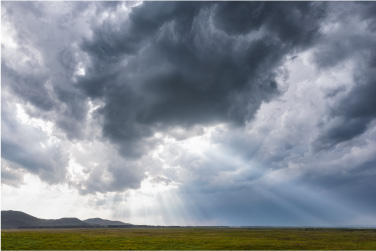How climate risk can impact your portfolio
Economists predict that if global temperatures continue to rise, global GDP may fall. Our strategists offer ideas to mitigate risk in your portfolio and take advantage of potential investment opportunities.
July 2023 was the hottest month on record to date,1 prompting a warning from the United Nations that the new reality amounts to “global boiling.”2 The implications are financial as well as environmental. Without a sharp reduction in carbon emissions, temperatures could rise by over 3 degrees Celsius above preindustrial levels by the end of this century, which could in turn decrease global GDP by an estimated 25%.3

When weather like storms, wildfires and floods occur, the economic impact is inevitable. Think about the lives impacted, buildings and infrastructure damaged, businesses shut down, medical and emergency costs incurred and insurance rates rise.
5 key questions answered
To jump to a specific question, click on a link below.
Are climate risks already priced into the markets?
How can investors evaluate climate risk in their portfolios?
How can investors lower their exposure to climate-related risk?
Which commodities could be attractive in a net-zero carbon future?
What investment opportunities does the Inflation Reduction Act create?
“While the movement to better understand and price climate risk is gaining momentum, it’s just one of many types of investment risk investors should consider.”
#1. Are climate risks already priced into the markets?
Yes and no, says Sarah Norman, head of Sustainable Investing Thought Leadership for the Chief Investment Office, Merrill and Bank of America Private Bank. “The drop in valuations for domestic coal over the past decade may be the best example of an industry feeling the effects of the move toward renewable energy solutions.” Likewise, stocks related to electric vehicles have been trading at higher multiples than traditional automakers. In fixed income, green bonds have traded at premiums compared with bonds lacking a green focus, Norman adds.
Yet climate risk assessment methods are still developing, and risks in some market areas, such as municipal debt pricing and real estate in coastal regions prone to extreme weather events, remain hard to quantify.
What to consider
“Investors can factor in climate risk by anticipating higher volatility in industries and countries related to fossil fuels or exposed to extreme weather,” Norman suggests, “or by considering investments in renewable energies, electric vehicles and green bonds.” They may also find opportunities in “transitional infrastructure” such as climate-resilient real estate and financing for low-carbon technologies.
How investors can factor climate risk into their portfolios:
- Anticipate higher volatility in industries and countries related to fossil fuels or exposed to extreme weather.
- Consider investments in renewable energies, electric vehicles and green bonds.
- Look for opportunities in transitional infrastructure such as climate-resilient real estate and financing for low-carbon technologies.
“Combining carbon emission data, transition risk and climate risk metrics can offer a clear picture of the extent to which a portfolio is exposed to climate-related risks and opportunities.”
#2. How can investors evaluate climate risk in their portfolios?
“Specific metrics can now assess the carbon footprint of individual companies and the risks for portfolios that invest in them,” says Ekaterina Gradovich, Investment Due Diligence Specialist for the Chief Investment Office for Merrill and Bank of America Private Bank.
“One widely used metric, carbon intensity, uses direct and indirect greenhouse gas emissions data and corporate revenue to objectively compare companies of different sizes.” While such metrics look at past data, an important and evolving area gauges future risks. “Many data providers now incorporate a company’s stated commitments, renewable energy investments, plans for transitioning away from fossil fuels and other data into their evaluations,” she adds.
What to consider
With companies under increasing pressure to report robust carbon metrics and publicly disclose their transition plans, investors can factor climate risk into their portfolios, Gradovich believes.
“In our view, renewable investments can now be integrated across many areas of an investment portfolio.”
#3. How can investors lower their exposure to climate-related risk?
“In our view, renewable investments can now be integrated across many areas of an investment portfolio,” says Anna Snider, head of Due Diligence for the Chief Investment Office for Merrill and Bank of America Private Bank. “Significant cost declines and technological improvements have made clean energy more competitive over the last two decades,”4 she adds.
Take advantage of potential opportunities
Snider suggests that investors look at a range of strategies that provide exposure to the energy transition across both asset class and risk and return profiles. This includes investing in resource-efficient companies and energy companies that are transitioning their revenue base from fossil fuels to clean energy, alternative energy technology solutions or infrastructure.
#4. Which commodities could be attractive in a net-zero carbon future?
Renewable power requires fossil fuels, metals and minerals, notes Joseph Quinlan, head of CIO Market Strategy for the Chief Investment Office for Merrill and Bank of America Private Bank. Copper, for example, is essential to electric vehicles, charging stations and supporting the electrical grid.5 Other essential commodities include cobalt, nickel and zinc, as well as water — large quantities of which are needed for mining and mineral processing. And even as society pushes toward that net-zero future, climate change will likely also mean higher prices for agricultural commodities.
The International Energy Agency estimates that if the world were to match renewable energy goals established in the 2015 Paris Agreement, mineral demand would double or quadruple over the next 20 years.6
Take advantage of potential opportunities
Look into commodities as part of a broader strategy of “FAANG 2.0” investments, Quinlan suggests. Areas that are likely to benefit during the energy transition are fuels, aerospace, agriculture, nuclear and renewables, and gold and other metals/minerals.

#5. What investment opportunities does the Inflation Reduction Act create?
Passed in 2022, the Inflation Reduction Act represents the most significant government climate investment in U.S. history, earmarking $369 billion for clean energy. “The goal, reducing greenhouse gases by 40 percent below 2005 levels by 2030, requires major capital expenditures on solar and wind, electrical vehicles and related infrastructure,” says Quinlan. The bill also includes a slew of tax credits and other incentives for businesses and consumers to invest in energy-efficient technologies and equipment.
“we believe it’s bullish not just for renewable stocks and electrical vehicles, but a much wider universe of sectors including industrials, materials, utilities and energy.”
Take advantage of potential opportunities
The law subsidizes and strengthens trends that were already underway, Quinlan notes. “Broadly speaking, we believe it’s bullish not just for renewable stocks and electrical vehicles, but a much wider universe of sectors including industrials, materials, utilities and energy. Qualified investors may also find supercharged opportunities in private markets, particularly in venture capital, growth equity, real estate and infrastructure strategies,” he says.
There’s a lot to consider when it comes to mitigating climate risk in your portfolio. An advisor can help.
How long will it take for new energy technologies to garner a larger share of the market? How much of a portfolio should be in old energy companies and how much in new energy companies? What are the risks inherent in new technologies?
Talking to your financial advisor about your personal goals and investment preferences is one of the best ways to address climate risk and other risks within your portfolio.
A private wealth advisor can help you get started.
1 NASA, “NASA Clocks July 2023 as the Hottest Month on Record Ever Since 1880,” August. 14, 2023.
2 United Nations, “Hottest July ever signals ‘era of global boiling has arrived,’ says UN chief,” July 27, 2023.
3 Group of Thirty, “Mainstreaming the Transition to a Net-Zero Economy,” October 2020.
4 Lazard, Levelized Cost of Energy Analysis. 2023.
5 Anderton, James. “Copper, the Critical Material for Transportation Electrification,” Engineering.com, February 7, 2023.
6 Merrill, Chief Investment Office Impactonomics®, Portfolio Construction and the Energy Transition: Q & A on What Investors Need to Know, September 2023.
Important disclosures
All investing involves risk. Past performance does not guarantee future results.
Risk management and due diligence processes seek to mitigate, but cannot eliminate risk, nor do they imply low risk.
Sustainable and Impact Investing and/or Environmental, Social and Governance (ESG) managers may take into consideration factors beyond traditional financial information to select securities, which could result in relative investment performance deviating from other strategies or broad market benchmarks, depending on whether such sectors or investments are in or out of favor in the market. Further, ESG strategies may rely on certain values-based criteria to eliminate exposures found in similar strategies or broad market benchmarks, which could also result in relative investment performance deviating.
There is no guarantee that investments applying ESG strategies will be successful. There are many factors to take into consideration when choosing an investment portfolio and ESG data is one component to potentially consider.
An investment in Green Bonds involves risks similar to an investment in debt securities of the issuer, including issuer credit risk and risks related to the issuer’s business. You should review the relevant offering document carefully before investing.Alternative investments are intended for qualified investors only.
There are special risks associated with an investment in commodities, including market price fluctuations, regulatory changes, interest rate changes, credit risk, economic changes and the impact of adverse political or financial factors.
Alternative investments such as derivatives, hedge funds, private equity funds, and funds of funds can result in higher return potential but also higher loss potential.



